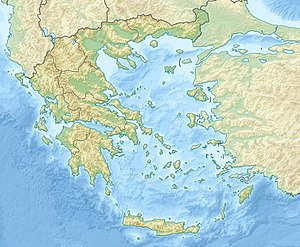Battle of Salamis
| Battle of Salamis | |||||||||
|---|---|---|---|---|---|---|---|---|---|
| Part of the Greco-Persian Wars | |||||||||
 A romantic version painting of the battle by artist Wilhelm von Kaulbach |
|||||||||
|
|||||||||
| Belligerents | |||||||||
| Greek city-states | Achaemenid Empire | ||||||||
| Commanders and leaders | |||||||||
|
Eurybiades, |
Xerxes I of Persia, Artemisia I of Caria, Achaemenes, Ariabignes †, Damasithymos † |
||||||||
| Strength | |||||||||
| 371–378 ships a | ~900-1207 shipsb 300–600 ships c |
||||||||
| Casualties and losses | |||||||||
| 40 ships | 200–300 ships? | ||||||||
|
aHerodotus gives 378 ships of the alliance, but his numbers add up to 371. b As suggested by several ancient sources; c Modern estimates |
|||||||||
|
|
|||||||||
The Battle of Salamis (/ˈsæləmɪs/; Ancient Greek: Ναυμαχία τῆς Σαλαμῖνος, Naumachia tēs Salaminos) was a naval battle fought between an alliance of Greek city-states under and the Persian Empire under King Xerxes in 480 BC which resulted in a decisive victory for the outnumbered Greeks. The battle was fought in the straits between the mainland and Salamis, an island in the Saronic Gulf near Athens, and marked the high-point of the second Persian invasion of Greece.
To block the Persian advance, a small force of Greeks blocked the pass of Thermopylae, while an Athenian-dominated Allied navy engaged the Persian fleet in the nearby straits of Artemisium. In the resulting Battle of Thermopylae, the rearguard of the Greek force was annihilated, whilst in the Battle of Artemisium the Greeks had heavy losses and retreated after the loss at Thermopylae. This allowed the Persians to conquer Boeotia and Attica. The Allies prepared to defend the Isthmus of Corinth whilst the fleet was withdrawn to nearby Salamis Island.
Although heavily outnumbered, the Greek Allies were persuaded by the Athenian general to bring the Persian fleet to battle again, in the hope that a victory would prevent naval operations against the Peloponnese. The Persian king Xerxes was also eager for a decisive battle. As a result of subterfuge on the part of Themistocles, the Persian navy rowed into the Straits of Salamis and tried to block both entrances. In the cramped conditions of the Straits, the great Persian numbers were an active hindrance, as ships struggled to maneuver and became disorganized. Seizing the opportunity, the Greek fleet formed in line and scored a decisive victory.
...
Wikipedia

